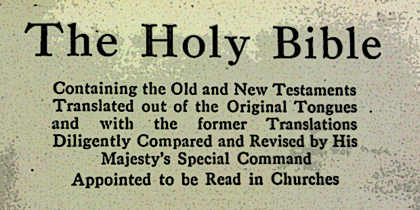
June 13, 2012, by Jonathan
Dawkins said what?!
Dawkins said what?!
On Monday (May 28h) the Observer carried an article where Richard Dawkins was waxing lyrical about the Bible.
The surprising thing was that he was supporting Michael Gove’s plan to give all schools a King James Bible:
“The good book should be read as a great work of literature – but it is not a guide to morality, as the education secretary Michael Gove would have us believe”
He goes on….
“A native speaker of English who has never read a word of the King James Bible is verging on the barbarian.”
We should – Dawkins thinks – read the King James Bible because we will then be disavowed of the illusion that it gives any worthwhile moral advice. We will be both astounded by its literary genius as well as appalled by its moral corruption, incoherence and in some places evil.
“I have an ulterior motive for wishing to contribute to Gove’s scheme. People who do not know the Bible well have been gulled into thinking it is a good guide to morality. … The surest way to disabuse yourself of this pernicious falsehood is to read the Bible itself.”
Let’s assume for the sake of argument that the moral guidance in the Bible is evil. There are then some interesting questions to ask about whether this moral judgement is aesthetically relevant to the work. That is, should a moral feature of an artwork – such as the King James Bible – be considered relevant to the aesthetic features? You might think the answer is ‘no’. The aesthetic is one thing, the moral another; these are simply two different things – like chalk and cheese. If this is correct then Dawkins can assert without conflict that the Bible is morally evil and that it is has great aesthetic value.
But you might not be convinced because in some cases it does seem like we can criticize an art work- as artwork – on moral grounds. Consider a famous example from the philosophical literature: Leni Riefenstahl’s film Truimph of the Will. This film is often taken as a brilliant piece of film making, one which expresses great aesthetic value.
However, the film is Nazi propaganda propagating and justifying a perverted world view, turning for example, Hitler into a Messianic figure. Learning this you might take a step back from your original aesthetic pronouncement. Do you still want to claim that has great aesthetic value? You might now be hesitant.
Consider another example: some years ago a picture of Mira Hindley was created out of children’s hand prints. Does calling it a great piece of art leave you feeling uneasy? Doesn’t our judgement about the moral influence our judgement about the aesthetic in this case?
We might interpret these feelings and conclude that aesthetic value is determined by or reduced to moral value. This would make Dawkins’ claim that the King James Bible is both a brilliant piece of literature and morally evil hugely problematic. How can the King James Bible be of great aesthetic value if it’s aesthetic value is so closely tied to its moral value?
For my money both of these extremes are – well – too extreme. What is called for is a moderate moralism. This position holds that in some instances a moral defect can be an aesthetic defect. This sort of position is precisely what is most often adopted and discussed in philosophical aesthetics. Of course, even though this might be the correct view and one which fits with our everyday talk, it doesn’t give Dawkins what he wants. We still need an answer to this question: in which cases does a moral evaluation matter to aesthetic evaluation? It is only by answering this question in a very specific kind of way that Dawkins could claim that his moral evaluation of the King James Bible doesn’t get in the way of his aesthetic evaluation. It’s really not clear that there’s an obvious way in which he can give such an answer.
No comments yet, fill out a comment to be the first

Leave a Reply